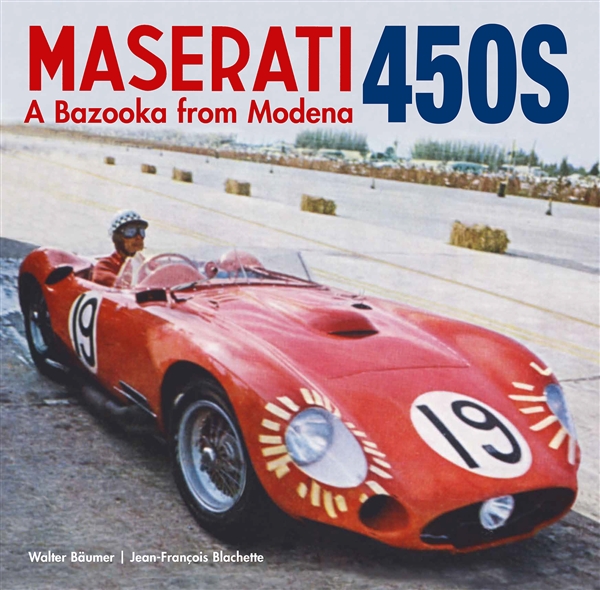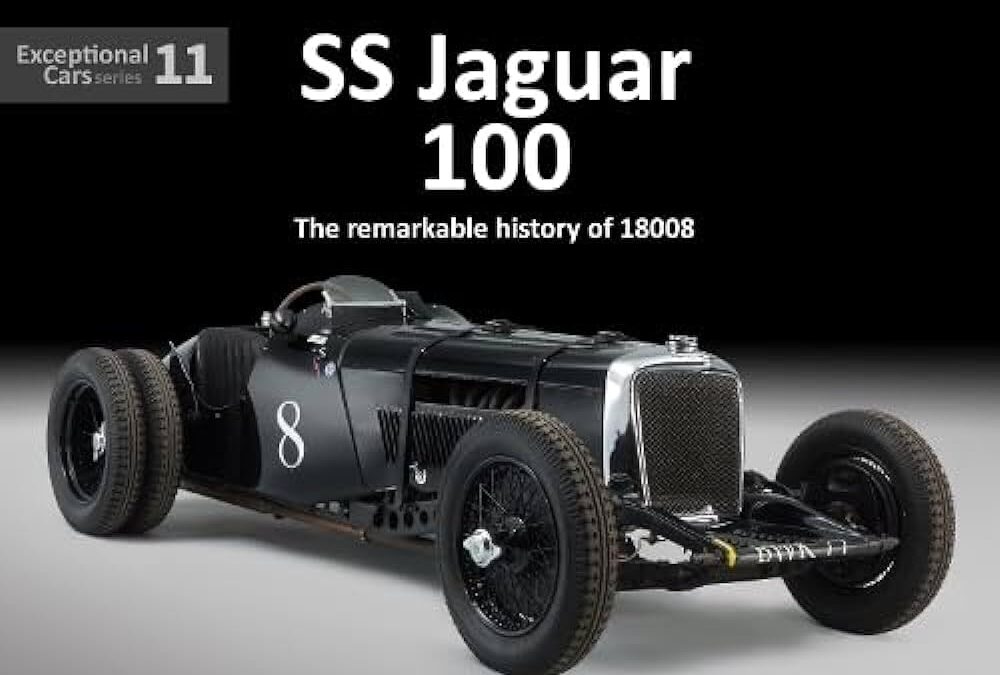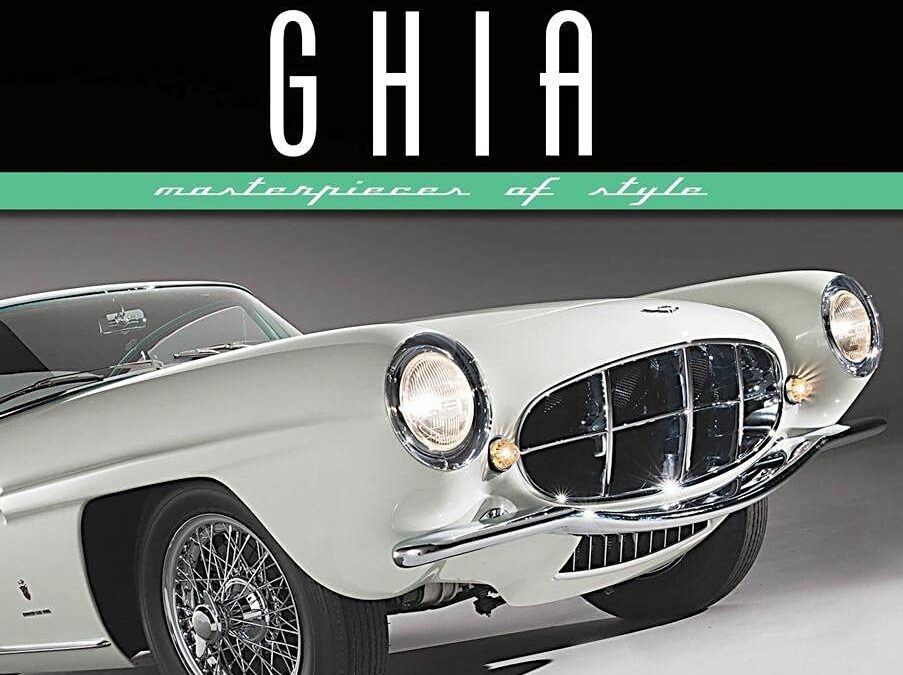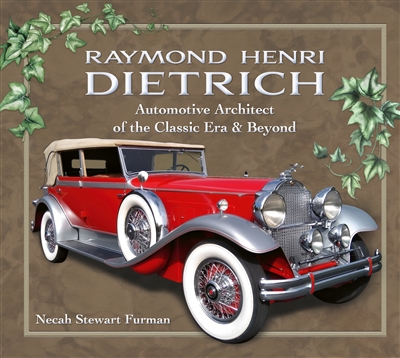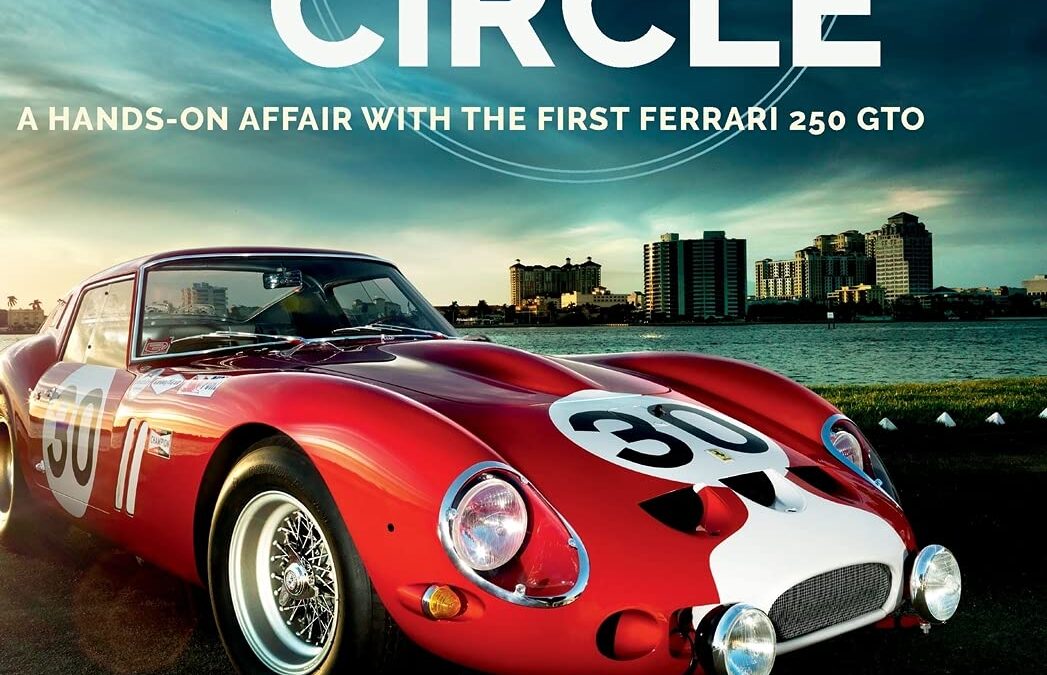
FULL CIRCLE: A Hands-on Affair with the First Ferrari 250 GTO may be the first car memoir – a car revered for its international racing performance and artistic mystique – the first Ferrari 250 GTO, born in Italy in 1962.
It is also the memoir of a man, himself unique – Larry Perkins, a rocket scientist /car racer /artist. His stories chronicle how The Car (a.k.a. “Sophia” named for the elegant Italian bombshell Sophia Loren) pops in and out of his life. These events, and the people associated with them, create a series of full circles in their shared journey.
Full Circle: the past becomes future becomes past, illuminating words to the famous song… “When Everything Old is New Again”.
While Larry was working on the Apollo program to land a man on the moon, and later the Viking Mars Lander program and other space missions, Sophia and Larry had an on-again off-again relationship – an “affair” so to speak – for over 50 years. They found each other in 1963 and formed a surprising dynamic of man-machine synergy. Life was fast and furious, fun and full of trophies. When it seemed destined to be over, Larry sold the Ferrari in 1966 for a mere $3600. The racing duo lost track but were re-united and then parted again. Finally … unbelievably … Sophia found Larry when they were both a little older. With the spark alive, their racing history was re-born in a most spectacular way. Each was transformed by the other.
The memoir starts with a man searching for the perfect race car and develops into a previously unrecorded history of s/n #3223 GT with racing tales. Larry and his wife, Petra, tell of an irresistible GTO attraction and adventures during the exciting era of ’60s sports car racing. (Petra first saw the Ferrari at a memorable race with a fiery crash at Sebring, Florida, when she was 15, but did not meet its driver for 15 more years.)
The authors show the exhilaration of key races and an anecdotal chronology of #3223 with photos, some never seen. They examine what a race driver is really like, the attributes of a highly competitive personality, and the unrelenting dedication to Winning. After all, it was not easy for a small privateer – someone who had started racing relatively late in life (with a consuming day job) – to compete with the likes of racing champions Phil Hill, Pedro Rodriquez, Mario Andretti, and Dan Gurney.
The book emphasizes the value of teamwork. “Doing the impossible” – in racing or rocketry – demands the best of humans working together to render perfect machines. This is an intimate account about the people who made The Car what it ultimately became.
How did this car acquire its timeless aura of mystique?
How cool is it to drive such a powerful and exquisite piece of machinery?
To what degree can a car be considered fine art?
What happened to Larry and why did it turn out to be so spectacular, almost eclipsing his early successes in racing the GTO? When and Where did all this happen?
And best of all, Who are the passionate people that made it happen?
Full Circle: A Hands-On Affair with the First Ferrari 250 GTO answers these questions and provides readers with a thrilling personal play-by-play of racing the very first Ferrari GTO for the very first time.

San Francisco lures people in search of a wide variety of treasure: fame, wealth, property, inspiration, love, family, community, freedom, and a fresh start. With this book in your hands, you hold a treasure map to the history of the City by the Bay―from its earliest days to more modern times. Solve 360 rhyming clues that take you on a scavenger hunt through 19 different neighborhoods across the 49 square miles of San Francisco. Each riddle includes a photo to help you find museums, public artworks, historical sites, bars and restaurants, architectural highlights, and more. Whether you love the thrill of solving a puzzle, have a desire to learn a little history, feel the urge to get out and explore, or even rediscover a city you thought you knew, find the true spirit of San Francisco in the pages of this book. Author and travel journalist Jill K. Robinson left her heart in San Francisco in her earliest childhood years. She brings her years of research, love for the city, and countless hours of exploring to this epic scavenger quest. Come with an adventurous spirit, and whether you solve the clues alone or with family and friends, this creative excursion will help you unlock the secrets of San Francisco.

For Jeep fans, Jeep owners, and even those just contemplating the purchase of a Jeep, there is no substitute for this incredibly popular, versatile vehicle-over 3.5 million Jeeps have been sold since 1945. And for everything you need to get the most out of Jeep ownership, there is no substitute for “Jeep Owner’s Bible”(tm) by Moses Ludel, recognized as the most comprehensive, authoritative guide to the Jeep ever published. In the words of “Jeep Owner’s Bible”(tm) author Ludel, “For those who never intend to work on their Jeep themselves, the “Jeep Owner’s Bible”(tm) provides basic orientation, explains mechanical features of Jeep 4WD trucks, offers valuable troubleshooting tips and makes it easier to discuss repair or modification work with a professional mechanic. For the do-it-yourselfer, “Jeep Owner’s Bible”(tm) serves as a technical guide, model review, and data source….Equipped with this book and a genuine Jeep factory service manual for your model, you can
accomplish quality repairs or a complete mechanical restoration.” Now completely revised and updated since its original publication in 1992, in addition to all the invaluable content of the first edition, this informative volume includes:
Coverage of all Jeeps built since 1945, through 1999, including Grand Cherokee and Wrangler TJ and YJ models
Substantially more material on YJ Wrangler, XJ Cherokee, and ZJ Grand Cherokee
Introduction of the new 1999 WJ Grand Cherokee
Many new “state of the art” improvements, accessories, and aftermarket products, including factory and non-factory products available since 1992
Additional sources for parts to restore, upgrade, and modify Jeep vehicles

The Audi R8 was the first in a line of world-beating sports-prototype cars from the Ingolstadt marque which would dominate Le Mans, and would see Audi remain at the forefront of international sports-car racing for over 15 years.
If such an award could go to a machine, Audi ‘R8-405’ – the car featuring in this book – was surely the ‘Man of the Match’ for the 2000 Le Mans 24 Hours. In the end it would finish second, behind one of its team mates which had a far less-troubled run, but it was not for want of trying by Allan McNish, his co-drivers Stéphane Ortelli and Laurent Aïello and their mechanics.
The Audi R8s would go on to dominate endurance racing for a further five years. The cars had already shown what they were capable of by finishing first and second on their debut, in the 12 Hours of Sebring in March 2000.
At Le Mans, apart from a brief aberration when a Panoz led under a full course yellow, ‘R8-405’ led the race for six hours. Trouble then intervened, but the car’s drivers never gave up, McNish setting fastest lap of the race in the morning still chasing his team mates Frank Biela, Tom Kristensen and Emanuele Pirro in the eventual winning sister car. That car would soon be on its way to Audi’s museum, but ‘R8-405’ would race on in the American Le Mans Series (ALMS), driven later that year by Biela and Pirro and winning at Texas Motor Speedway and Las Vegas.
By the end of the season, ‘405’ and the other 4-series 2000-season R8s would be rendered almost obsolete by Audi’s introduction of a direct-injection engine for its new 5-series R8. That did not stop ‘405’ from competing for a further year in the ALMS, albeit in private – Champion Racing – hands, with regular drivers including Andy Wallace and Johnny Herbert. Despite its tender years, it would later go on to qualify as an historic car, and a host of new opportunities opened up as it became one of the most raced of all the R8s.
In 2020 the car was acquired by enthusiast Martin Halusa with every intention of taking it back to Le Mans in the future for the biannual Classic races.
The enthralling story of ‘R8-405’ is told in fascinating detail in this book, supported by a stunning array of photographs showing the car in action in its two years of ‘period’ competition, together with a gallery of fine studio images showing this ‘Great Car’ as it is today.
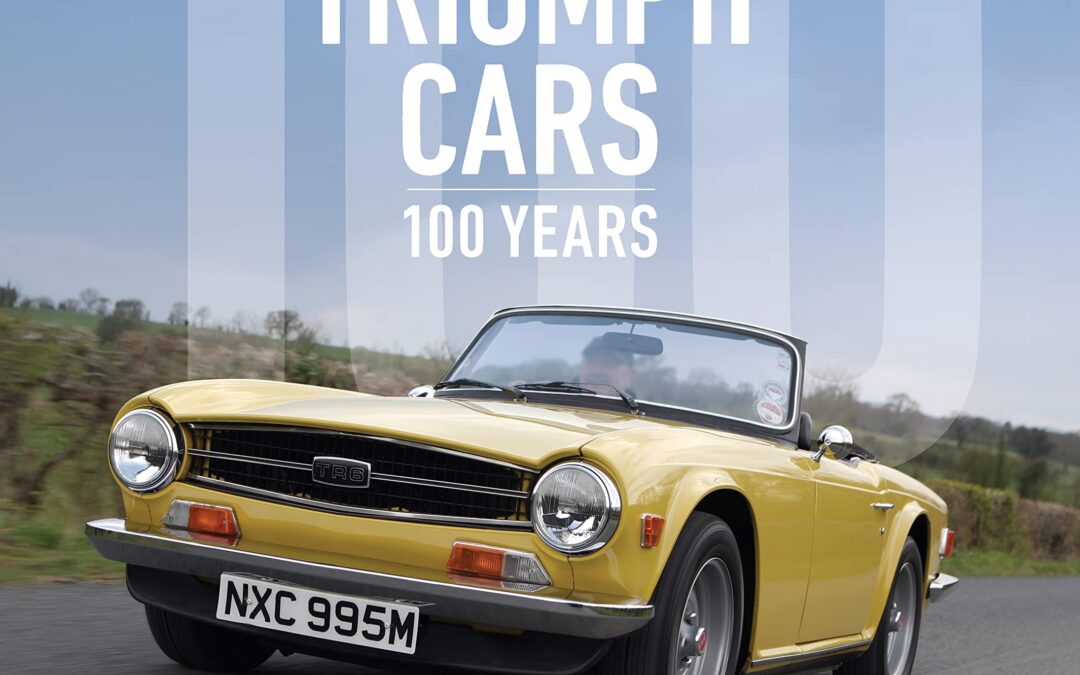
Experience the entire history of Triumph sports cars in this comprehensive volume featuring stunning studio photography, rare archival images, and period advertising.
Triumph Cars chronicles the company and its remarkable vehicles, from the first 10/20 through a string of automobiles sought after by collectors, from the early Supers and Glorias through the entire TR and Spitfire ranges, and on to the legendary GT6 and the latter-day 1300, 1500, and Dolomite sedans—filled with images, history, and in-depth analyses of players, tech, and styling.
With roots extending to a London bicycle importer established in 1885, Triumph built its first car in 1923: the Triumph 10/20. By 1930, the Triumph Cycle Co. had become Triumph Motor Company and was on its way to establishing seven decades of automotive heritage.
Author Ross Alkureishi showcases how company visionaries developed the brand—and how the brand changed hands—in the trying economic times of the 1930s and during the war years. The Standard years beginning in 1944 are also examined, along with associations with Jaguar and the range of roadsters and saloons developed, arguably peaking with the introduction of the TR2 sports car in 1953.
Alkureishi proceeds through the stylish 1950s cars and on to the Leyland years beginning in 1960, and associated engine and styling developments. The story ends with the last Triumph model, the Acclaim introduced in 1981, and the marque’s subsequent mothballing. Along the way, Alkureishi also highlights Triumph motorsport exploits, particularly in the realm of rally cars.
From the 1923 steel-paneled 10/20 through a range of roadsters, saloons, and sports cars, Triumph Cars offers a definitive review of an iconic British marque. The book is illustrated with hundreds of historic, contemporary, and racing photographs, as well as detailed text. This is the one volume no sports car enthusiast can be without.
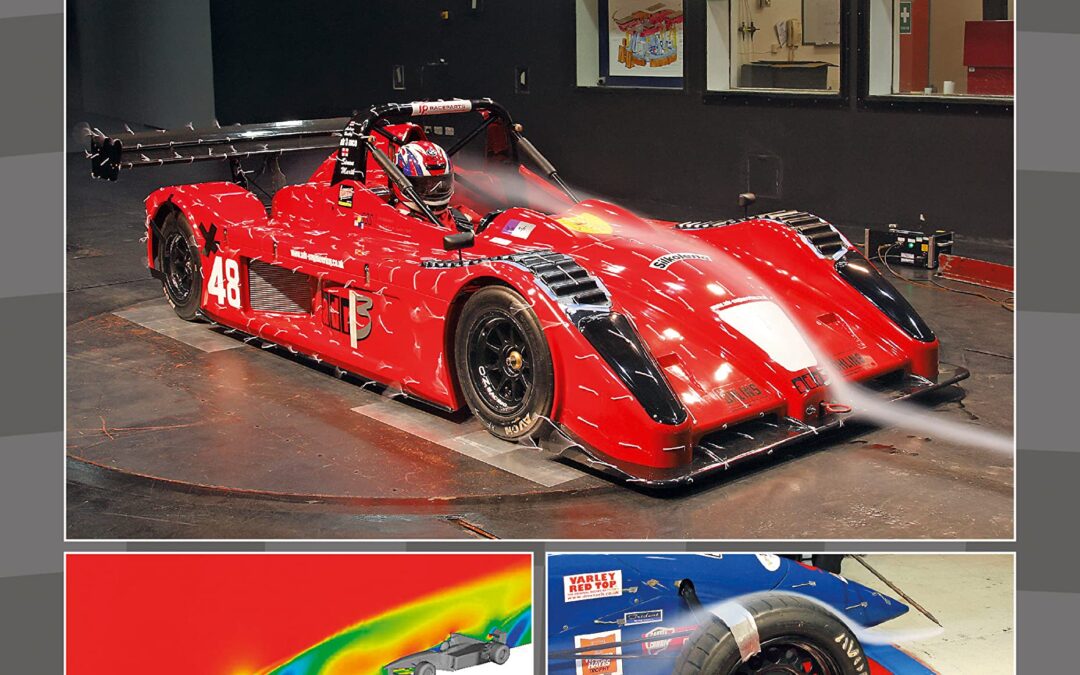
The field of aerodynamics has had an increasingly significant effect on performance enhancement over the past 50 years. Competition Car Aerodynamics 3rd Edition continues the practical, hands-on approach of its popular predecessors to cover all aspects of motorsport aerodynamics, with more CFD and wind tunnel project material and case studies. Author Simon McBeath tackles aerodynamic theory in a comprehensive, yet comprehensible, way with his unprecedented access to state of the art computational fluid dynamics (CFD) techniques. McBeath also explores aerodynamics with the MIRA full-scale wind tunnel in the UK. Photographs, graphs, CFD-generated images, and wind tunnel data–much of which has appeared in the successful Aerobytes series in Racecar Engineering–are used to explain with unrivaled clarity how aerodynamic performance benefits are obtained in practice. With case studies from Formula 1, sports prototypes, Formula 3, GT and saloon cars, club single seaters, and karts, this book will appeal to anyone, whether a designer, competitor, student, or armchair enthusiast, wishing to gain an understanding of aerodynamics, and how it can benefit the performance of all types of competition cars.
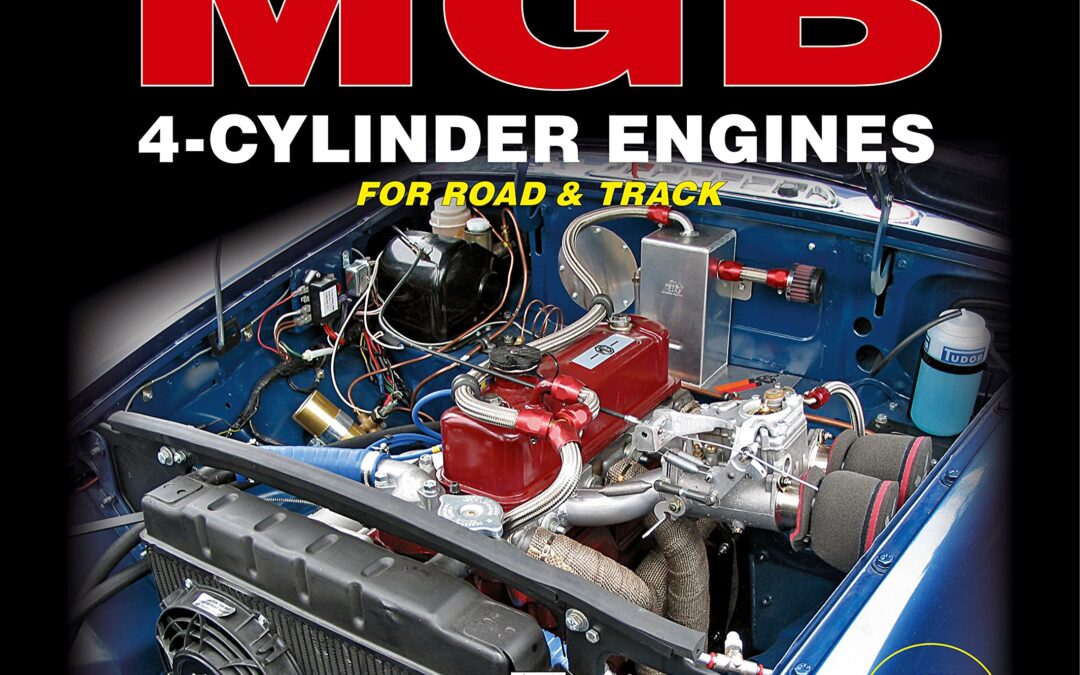
How to get maximum performance from the MGB’s four-cylinder B-series engine for road or track.This book tells you all you could want to know, expert tips, and is packed with understandable and down-to-earth advice based on the author’s years of hands-on experience. ·Covers all MGB and MGB GT 4-cylinder engines (except 3-bearing crank engines) ·Explains the ‘first principles’ of engine power and tuning ·Handy ‘power recipes’ to help achieve the performance you want ·How to improve airflow, camshafts, carburation, ignition and exhaust ·Lubrication and cooling systems improvements ·Uprating suspension, wheels, tyres and steering for better handling ·How to set-up and tune on a rolling road ·Comprehensive appendix with formulae and tuning data ·Includes cam timing tables for Piper and Kent cams ·List of specialists and suppliers to help with your MGB tune. Written by an acknowledged expert, who runs a well-known tuning business in Derbyshire, England. Peter Burgess has been working with MGBs since 1978 and his engine building expertise has produced many MGB race wins. He is also the author of How To Build, Modify & Power Tune Cylinder Heads.

Porsche 356: 75th Anniversary relates the full story of Porsche’s original sports car from the first Gmund coupe to today’s beloved collector car.
Ferdinand Porsche was a brilliant engineer who, prior to World War II, had been involved in a variety of significant automotive engineering developments including the first hybrid drive vehicles. From the early 1900s, Porsche was developing racing cars including the Mercedes SSK and the mighty Auto Union Grand Prix. During this period, Porsche also developed the groundbreaking Volkswagen, which would prove critical to his postwar, namesake automobile manufacturer.
The Typ 356 was developed by Ferdinand’s son “Ferry” Porsche and introduced in 1948. Though the rear-engine layout was based on the Volkswagen, most similarities ended there. The 356 had a unique chassis, higher performing engine, and a handsome wind-cheating body. Little known outside Germany initially, by the early 1950s the 356s were lauded for their excellent handling, build quality, and growing volume of competition successes.
Porsche’s 356 evolved over its 17-year life through four distinct series: pre-A, A, B, and C, with coupes, cabriolets, Speedsters, Hardtops, and Roadsters among the many body variations. Equipped with the “Carrera” 4-cam engine, the 356 was a force in sports car racing. Dedicated competition models were developed beginning in 1953, and the Rennsport Spyders dominated road racing, endurance, and hill climb events for over a decade.
The 356 story includes a cast of fascinating characters, from those engineers who designed the cars, to race drivers who built the “giant-killer” mystique, to owners like James Dean and Janis Joplin who fell in love with the little bathtub-shaped sports cars. From titled European gentlemen in the 1950s to movie stars like Paul Newman and Steve McQueen in the 1960s, the first Porsches attracted enthusiasts and racers alike. Today, the car has an even wider following among collectors including Porsche fans like Jerry Seinfeld and Jay Leno. “356 Fascination” continues with ongoing restoration efforts, vintage racing, and an “Outlaw” movement, all enhanced by large-scale events that celebrate the car’s history.
Porsche 356 75th Anniversary tells the in-depth story and is a must-have book for anyone that loves Porsche and sports car history.
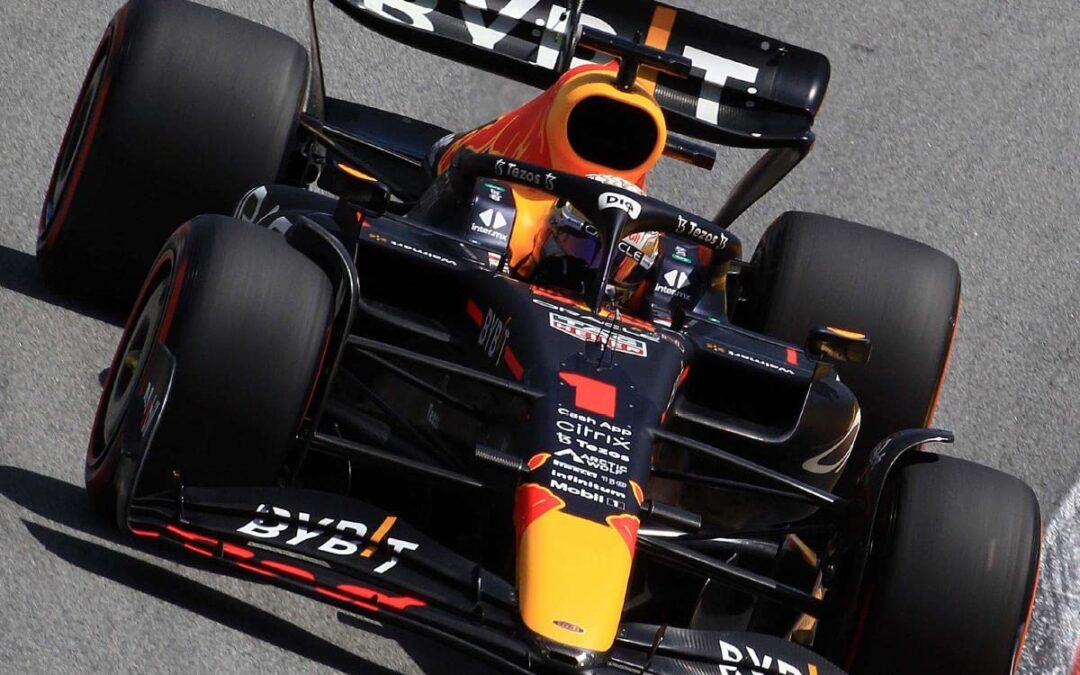
72nd YEAR OF PUBLICATION
Another record-breaking 22 Grand Prix season saw Red Bull Racing and Ferrari go head-to-head with some spectacular races and epic drives from all four drivers, each one winning one or more races. Mercedes with Lewis Hamilton and new recruit George Russell struggled for most of the season with aero and relentless porpoising until mid-way through the season when their performances improved and some notable qualifying and race results appeared, but far too late to challenge for the top spot.
There were some flashes of brilliance from the midpack consisting of Alpine, McLaren, Alpha Tauri, and Alfa Romeo, but Aston Martin, Haas, and Williams continued their struggle for consistency.
Authors Tony Dodgins and Maurice Hamilton, combining 80 years of F1 expertise, examine each round in depth. Full race reports are backed by detailed results, including lap charts and tire strategies.
The nuances of F1’s designs and development are analyzed team by team by the much-respected Mark Hughes, enhanced by Adrian Dean’s handsome F1 car illustrations.
Motor racing’s other major categories are also fully covered: Toyota’s WEC and Le Mans sports car successes; the closely fought Formula 2 and Formula 3 championships, featuring emerging young talent from around all continents of the world; and the tightly fought Formula E series for electric powered single seaters.
AUTOCOURSE includes all the hectic action from the top Touring Car series – the World Touring Car Cup and the British Touring Car Championships as well as the DTM Series running GT cars from Audi, Mercedes, BMW and Ferrari.
From America, Gordon Kirby recounts a thrilling Indycar series, featuring a mix of youthful talent such as Alex Palou and Pato O’Ward, both of whom vying to overturn the established veterans who have dominated proceedings over the past decade. The ever-popular NASCAR stock car series ran from February to November with barely a weekend’s break, to feature more than forty races before the final championship play-off round at Phoenix, Arizona.
In a single essential volume, AUTOCOURSE provides the most comprehensive record of world motor sport, complete with full results not found anywhere in a single volume.
It is required reading for all motor sport fans worldwide.
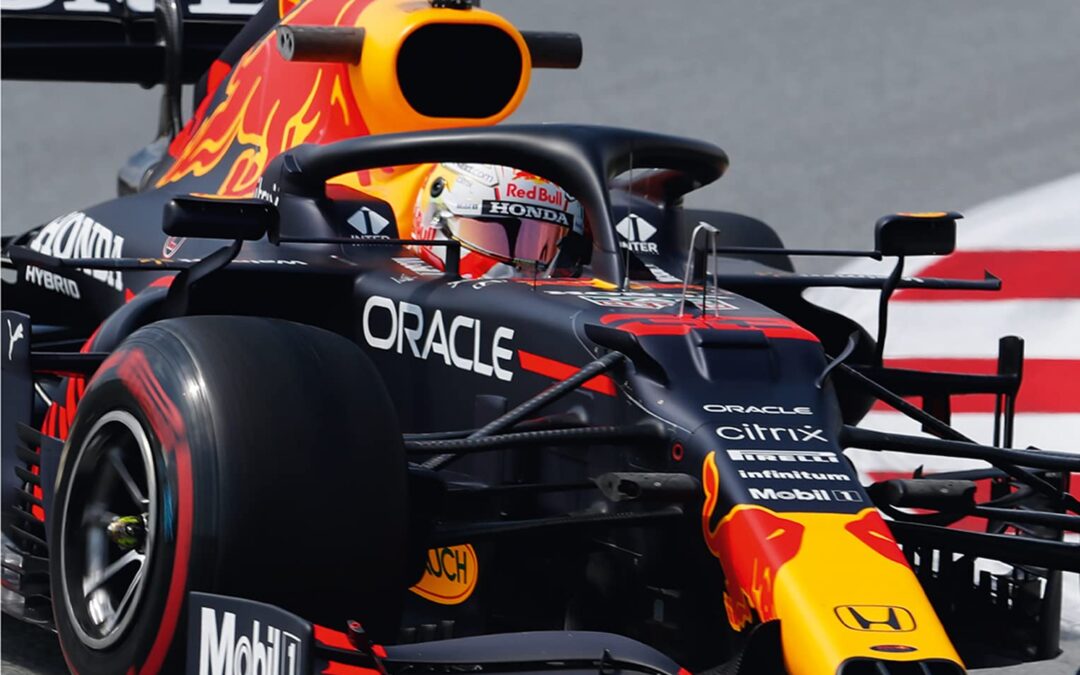
71st YEAR – First published in 1951 – The longest running motor racing yearbook. Independent and authoritative editorial combined with the sport’s finest photography Despite the pandemic, AUTOCOURSE celebrated its 70th year of publication in 2020, a year turned on its head by Covid-19. Thanks to the FIA and racing’s management, F1 was rescued, with a compelling 17-race championship spanning Europe and the Middle East. For 2021 a record 22-race schedule was planned, and despite changes to venues, the F1 championship was very much up and running by March 2021. Mercedes and Lewis Hamilton – now the winningest driver in history – broke more records. The Briton smashed through the 100 pole-position barrier, and moved inexorably toward a century of Grand Prix wins in the face of a real championship challenge from Max Verstappen. Red Bull Racing and Honda seemed to have all but matched Mercedes to provide the fans with a thrilling wheel-to-wheel battle, which would end up with some controversial collisions as the season reached boiling point. Authors Tony Dodgins and Maurice Hamilton, combining almost 80 years of F1 expertise, examine each round in depth. Full race reports are backed by detailed results, including lap charts and tyre strategies. The nuances of F1’s designs and development are analysed team by team by the much-respected Mark Hughes, enhanced by Adrian Dean’s handsome F1 car illustrations. Motor racing’s other major categories are also fully covered: Toyota’s WEC and Le Mans sports car successes; the closely-fought F2 and Formula 3 championships, featuring emerging young talent from around all continents the world; and Nick de Vries emerging victorious in the tight fought Formula E series for electric powered single seaters. AUTOCOURSE includes all the hectic action from the top Touring Car series – the World Touring Car Cup and the British Touring Car Championships as well as the reconfigured DTM Series now running GT cars from Audi, Mercedes, BMW and Ferrari. From America, Gordon Kirby recounts a thrilling Indycar series, featuring a mix of youthful talent such as Alex Palou and Pato O’Ward, both of who were vying to overturn the established veterans who have dominated proceedings over the past decade. In an emotional return, Helio Castroneves took record equalling fourth Indy 500 victory, whilst an appreciation is made to paid to the legendary three-time Indy 500 winner the late Bobby Unser. The ever-popular NASCAR stock car series ran from February to November with barely a weekend’s break, to feature more than forty races before the final championship play-off round at Phoenix, Arizona. In a single essential volume, AUTOCOURSE provides the most comprehensive record of world motor sport, complete with full results not found anywhere in a single volume. It is required reading for all motor sport fans worldwide

VW Classic Beetle is the latest in the Maintenance and Upgrades Manual series, which are based on real-life experience and written by expert authors. The original air-cooled VW Beetle is a hugely distinctive and popular classic car with over 21 million produced over a 65-year period. It is also an ideal starter classic for anyone looking to get their hands dirty. This new book includes an illustrated timeline to the various models produced and a useful buyers’ guide with a systematic approach. There is information on workshop tools and equipment and a service and maintenance schedule. How to maintain all aspects of the engine, transmission, brakes and bearings, suspension and electrics are covered. Information on modifications and upgrades for the engine, brakes and suspension including front beam, dropped spindles, spring plates, air ride, and wheels and tyres is included. Troubleshooting tips for when your car won’t start or won’t go into gear are given and, finally, tips on restoration of the paint and bodywork, or respray. There are useful chapters on fitting an ISOFIX base for a child safety seat, as well as fire suppression.
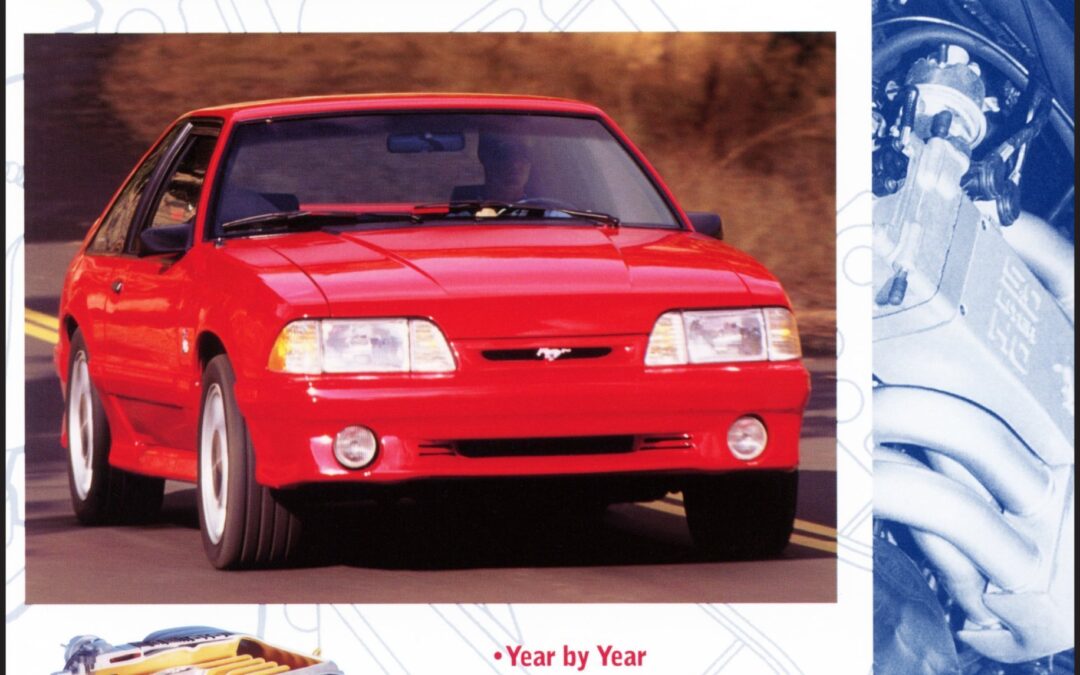
The Official Ford Mustang 5.0 Technical Reference & Performance Handbook View is the number-one data source for V-8 Mustang and Capri owners. It contains all the data you need to master a V-8 Mustang’s major mechanical workings. Most importantly, the Handbook provides you with the crucial keys to your car’s performance potential. And it features all the popular treatments and modifications that third-generation V-8 Mustang owners and tuners have found to be most effective.
Features
- Complete door tag and VIN translations, plus V-8 engine, transmission and rear end codes.
- A year-by-year (1979-93) review of what Ford built, with a breakdown of powertrain and driveline specs for V-8- Ford Mustang and Lincoln-Mercury Capri models. Restorers! Read this reference guide before you turn a wrench.
- Critical specs and detailed data on all production 5.0-liter H.O. and GT-40 engine hardware including, blocks, cranks, pistons, rods, heads, cams, intake, ignition, exhaust and cooling systems, as well as all factory-fitted transmissions and rear ends, plus suggested upgrades.
- Complete specifications on original equipment suspension, braking and steering systems, as well as popular improvement paths and equipment.
- Comprehensive coverage of the limited-production 1993 Mustang Cobra and the already rare 1993 Cobra R-Model.
- A complete review of Fox-body Mustang police cars, with detailed discussions of their Special Service systems and equipment.
- Parts and systems replacement references include interchangability, conversions, and swaps. Hands-on tips and tricks reveal low-cost horsepower sources. Analysis of the most effective approaches to improving a 5-liter Mustang�s output: supercharging, nitrous-oxide, turbocharging and increased displacement.
- Owners of 5-liter 1994-95 V-8 Mustangs and 1996-and-later Explorers and Mountaineers will find applicable cross-over data in the coverage of Ford’s fuel-injected small block V-8.
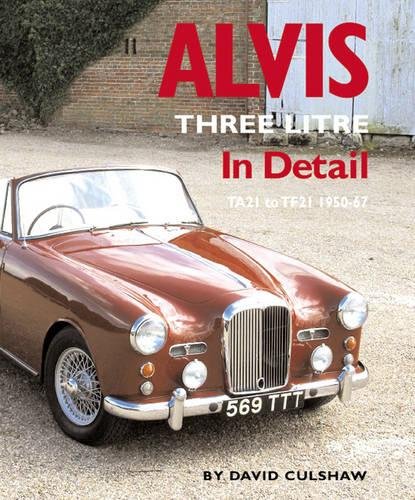
From its launch in 1950 to its demise in 1967, the Alvis Three Litre enjoyed a deserved reputation for effortless performance, exceptional surefootedness and stability, a high degree of driver friendliness, and irreproachable quality of construction. It was considered a rather exclusive car, coming as it did from a maker whose products always had a certain individuality. In addition, there remained through successive models something reassuringly traditional about its styling in both saloon and drophead forms; while never outdated, it displayed a timeless, discreet dignity unmoved by the more frivolous vagaries of fashion. All the while, in the background but ready to serve when called upon, was the Alvis works, whose concern for its cars and their owners was exemplary.Throughout production, the Three Litre was based on the same chassis and was powered by the same engine. This was a handsome and efficient short-stroke six-cylinder, conceived in order to provide the driver with ample power over a very wide rev range. Starting with an output of 83bhp in the early TA21, this robust unit was progressively developed to supply 150bhp in its final TF21 form while retaining the turbine smoothness, reliability and lack of temperament that it had become celebrated for. It was perfectly matched to its chassis and running gear, and those who have driven a Three Litre at speed will find the dynamic qualities of the contemporary rivals from Bentley or Jaguar rather less likeable.This book opens with an exposition of the background that led to the companys introduction of the Three Litre in 1950. Then comes a detailed technical analysis of the TA21, covering all aspects of the chassis, running gear, engine and transmission. This sets the scene for the chapters which follow, on the short-lived TB21 sports tourer, the TC21 and the uprated TC21/100, the Graber-inspired TC108G, the outstandingly handsome TD21 Series I and II, the TE21 and the TF21.Each of these receives comprehensive treatment, including differences from previous models, production changes and full chassis number number listings, along with notes on famous owners and screen appearances. The author provides extensive information on the coachbuilders who supplied Three Litre bodies, including Mulliners, Tickford, Graber, Willowbrook and Park Ward, and there are chapters devoted to the Alvis-powered Healey G Series sports car, the aborted Issigonis-designed Alvis TA350, and the ownership and use of Alvis Three Litre models today.Five outstanding examples of the cars have been specially photographed for this book and are featured in some 70 colour shots. There are also more than 140 black-and-white illustrations drawn from archives as well as from Alvis sales and publicity material. Devoted exclusively to the Three Litre, this book offers an in-depth examination of these excellent cars to provide a store of information for the many owners who care passionately about them, and serve as a tribute to the men who made them.

Celebrate more than 100 years of Germany’s best two- and four-wheeled rides. This handsome volume is filled with images, history, and in-depth review of the incredible machines BMW has created year after year.
Established in 1916, BMW is one of the automotive and motorcycle industry’s oldest and most-respected manufacturers. Over the past 100-plus years, the company has passed through myriad incarnations. The BMW Century chronicles this remarkable transportation story through the cars and motorcycles manufactured, from the 1923 R32 motorcycle to today’s sleek electric, hybrid, and high-performance cars.
The BMW Century showcases how the company’s visionary team systematically rebuilt BMW in the post-World War II years into the spectacular success we know today—a company with sales in excess of two million cars annually, led by its top-selling 3-series.
BMW’s motorcycle division is no less legendary. It began with the 1923 avant-garde R32, which featured a 180-degree, horizontally opposed twin, the engine configuration that would become BMW’s hallmark. Over the decades, BMW used that configuration to power groundbreaking machines like the R90S, R100RS, and R80GS. Beginning in 1983, the company added add three- and four-cylinder machines to their offerings, culminating in today’s spectacular S1000RR sport bike.
From the pre-war motorcycles to the iconic R-series twins of the 1970s and ’80s to the mighty M-cars and superbikes of today, The BMW Century offers a full review of German engineering at its zenith. The book is illustrated generously with hundreds of historic, contemporary, and racing photographs—many sourced from BMW’s historic archives—and thorough text covering BMW’s full history.
This is the one volume no BMW aficionado will want to be without.
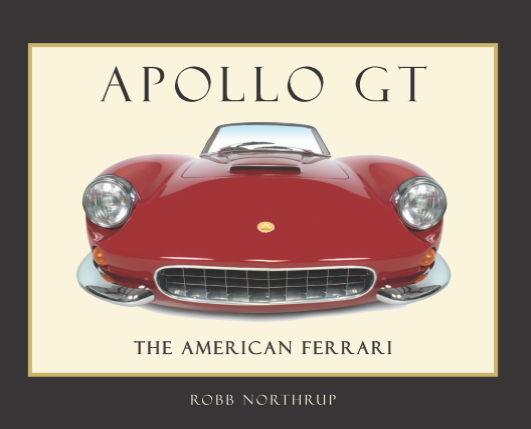
‘If a Buick Special ever got a fierce ambition to become a Ferrari – and tried hard enough – it would be likely to end up just about like this.”
Car and Driver magazine – September, 1963
Such prophetic words from Car and Driver magazine back in 1963 underscore the goal of three California twenty somethings who sought to build a world-class grand touring sports car. And, for a while, found themselves on equal ground with Europe’s best.
Their concept: A marriage of Italian style and the mechanical excellence of a premier American manufacturer – Buick – to create a true gran turismo sports car with head-turning looks, outstanding performance and comfort, and something that, up to then, was not common among European exotics: Reliability!
Their challenges were legion: A complex product combining hand-crafted bodies with mass-produced engines and transmissions on an assembly line spanning two continents and an ocean. A limited capability for product development and testing. And the need to create a marketing program to promote the car to an enthusiast public as well as develop a distribution channel to get the car into their hands. All this with limited operating capital.
The result? The Apollo was highly praised by both road testers and owners alike. “Workmanship is of the highest quality…comparable to cars costing twice that of the Apollo” crowed one magazine report. “…the Apollo handles as well or better than a 2+2 Ferrari, an Aston Martin DB4 or a Sting Ray Corvette,” exclaimed another. High praise indeed from the critical press!
And the owners? “I dearly love my Apollo!” enthused singer Pat Boone. And this from another owner: “It’s a wonderful work of art. You can see the quality. You can feel the excitement they felt when they were hammering it out, putting it together and driving it for the first time. It is a milestone, a one-of-a-kind car and no one can really compare anything to it. It stands on its own.”
This is the story of the Apollo GT. The American Ferrari.
Details: 8.5″ x 11″, 138 pages. 87 color and black & white photos and illustrations.


